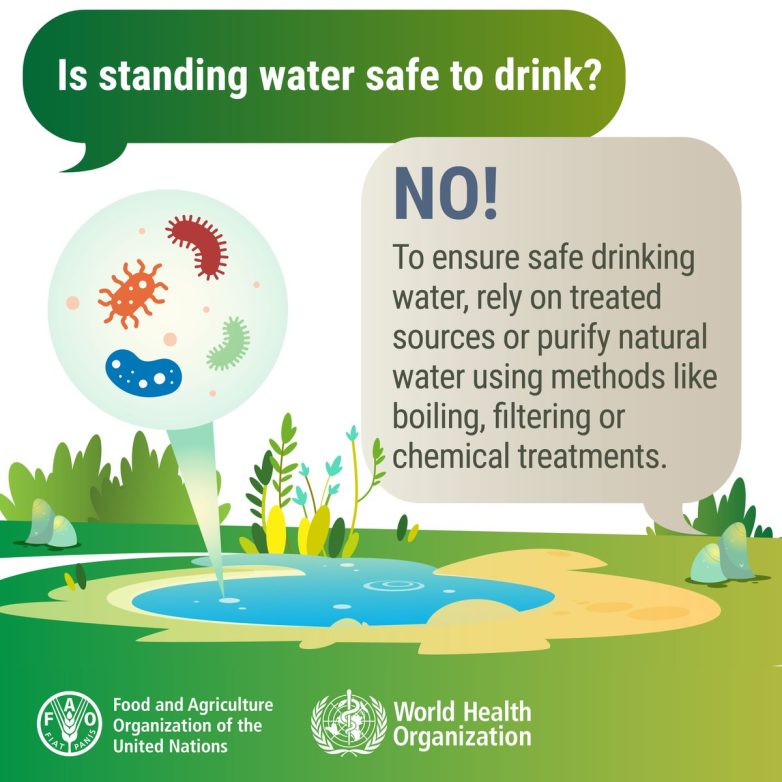
“Standing Water: Hidden Dangers Lurking in Your Glass!”
drinking water safety, water purification methods, contaminated water risks
Understanding the Dangers of Drinking Standing Water
The question of whether standing water is safe to drink is crucial for public health and safety. The World Health Organization (WHO) has addressed this topic, emphasizing the importance of relying on treated water sources or employing purification methods for natural water. This article explores why standing water is typically unsafe and outlines effective purification methods, ensuring you have access to safe drinking water.
The Risks of Standing Water
Standing water, which refers to water that is not flowing and remains stagnant, can present multiple health risks. It often serves as a breeding ground for various pathogens, including bacteria, viruses, and parasites. Common pathogens found in standing water include:
– **E. coli**: Found in fecal matter, this bacteria can lead to severe gastrointestinal issues.
– **Giardia**: A parasite that can cause giardiasis, leading to diarrhea and stomach cramps.
– **Legionella**: This bacteria can cause Legionnaires’ disease, a severe form of pneumonia.
In addition to microorganisms, standing water can also become contaminated with chemicals, debris, and pollutants, further compromising its safety for human consumption. The presence of algae blooms is another concern; these blooms can produce toxins harmful to both humans and animals.
Purification Methods for Natural Water
If you find yourself in a situation where you must use natural water sources, it’s essential to purify it before drinking. Here are some effective methods to ensure the water is safe:
1. Boiling
Boiling is one of the simplest and most effective methods for purifying water. By bringing water to a rolling boil for at least one minute (or three minutes at higher altitudes), you can kill most pathogens, including bacteria, viruses, and parasites. This method is particularly useful when you don’t have access to filters or chemical treatments.
2. Filtration
Using a water filter can effectively remove contaminants from natural water sources. Look for filters that can remove bacteria and protozoa, such as those with a pore size of 0.2 microns or smaller. Portable water filters are available for camping or emergency situations, making them a convenient choice.
3. Chemical Treatments
Chemical treatments, such as chlorine or iodine tablets, can disinfect water. These chemicals work by killing harmful microorganisms. It’s essential to follow the manufacturer’s instructions for proper dosages and waiting times to ensure the water is safe to drink.
4. UV Light Purification
Ultraviolet (UV) light purification is another effective method for treating water. UV light disrupts the DNA of microorganisms, rendering them harmless. Portable UV purifiers are available and can be a great option when you need to treat small amounts of water quickly.
Why Rely on Treated Sources?
The safest choice for drinking water is to rely on treated sources whenever possible. Water treatment facilities use various methods, including filtration, chlorination, and ozone treatment, to ensure that water is safe for consumption. Treated water undergoes rigorous testing and quality control measures, making it a reliable option for households and communities.
Using treated water helps prevent waterborne diseases and contributes to overall public health. In regions where access to clean water is limited, community efforts to improve water quality and accessibility are essential.
Conclusion: Prioritizing Safe Drinking Water
In summary, standing water poses significant health risks due to the potential presence of harmful pathogens and contaminants. To ensure safe drinking water, always opt for treated sources or employ purification methods like boiling, filtering, or chemical treatments. Staying informed about water safety and purification techniques is vital for protecting yourself and your family from waterborne illnesses.
By making informed choices and taking appropriate precautions, you can significantly reduce the risks associated with drinking unsafe water. Always prioritize your health and safety by ensuring the water you consume is clean and treated. For more information on food safety and water quality, consider referring to resources provided by health organizations like the World Health Organization (WHO).

Is standing water safe to drink
To ensure safe drinking water, rely on treated sources or purify natural water using methods like boiling, filtering or chemical treatments. #FoodSafety pic.twitter.com/K4jlbrprDo
— World Health Organization (WHO) Western Pacific (@WHOWPRO) June 8, 2025
Is Standing Water Safe to Drink? A Comprehensive Guide
When you come across a puddle or a pool of standing water, you might wonder, “Can I drink that?” This question is more common than you’d think, especially for those who find themselves in outdoor adventures, survival situations, or even after a heavy rain. In this article, we’ll delve into the safety of drinking standing water, the potential health risks involved, and how to ensure safe drinking water through various purification methods. Let’s dive right in!
Understanding Standing Water
Standing water is simply water that is not flowing or moving. This can include puddles, ponds, or any water that collects in a low-lying area. While it may look harmless, standing water can be a breeding ground for bacteria, viruses, and parasites. This makes it crucial to understand the risks associated with drinking it.
Health Risks of Drinking Standing Water
Drinking standing water can expose you to several health risks:
- Bacterial Infections: Bacteria thrive in stagnant water. Common pathogens include E. coli and Salmonella, which can cause severe gastrointestinal issues.
- Viral Infections: Viruses such as Hepatitis A can also be present in contaminated standing water, leading to serious liver disease.
- Parasitic Infections: Parasites like Giardia and Cryptosporidium can be found in untreated water, leading to prolonged illness.
- Pesticides and Chemicals: Standing water may collect runoff from nearby areas that could contain harmful chemicals or pesticides.
Given these risks, it’s clear that drinking standing water is not safe unless it has been treated or purified. Let’s explore how you can ensure the water you drink is safe!
How to Purify Standing Water
If you find yourself in a situation where you must drink standing water, there are several methods to purify it:
Boiling
Boiling water is one of the most effective ways to kill pathogens. Bring the water to a rolling boil for at least one minute (or three minutes at higher altitudes) to ensure it is safe to drink. This method is simple and requires no special equipment, making it a reliable option in emergencies.
Filtration
Using a water filter can significantly improve the safety of standing water. Look for filters that are designed to remove bacteria, viruses, and parasites. Portable filters are great for hiking or camping, and some are even designed for emergency situations. You can find a range of options online that fit your needs.
Chemical Treatments
Chemical treatments can also be used to purify water. Common methods include:
- Chlorine Dioxide: Tablets are available that can effectively kill harmful microorganisms.
- Iodine: Iodine tablets can be used to disinfect water, but should not be used by pregnant women or those with thyroid issues.
- Bleach: Regular household bleach (unscented) can purify water when used in the right concentration. Add 8 drops of bleach per gallon of water, stir, and let it sit for 30 minutes before drinking.
Always follow the instructions provided for any chemical treatment to ensure safe results.
Choosing Safe Drinking Water Sources
To avoid the dangers of standing water, it’s best to rely on treated and tested drinking water sources. Here are some tips for selecting safe water:
- Tap Water: Municipal tap water is typically treated and safe to drink, but always check your local water quality reports.
- Bottled Water: Commercial bottled water is generally safe, but be cautious of the source and check for certifications.
- Natural Springs: If you’re in a natural setting, look for clear, flowing water from a spring or river, as it’s less likely to be contaminated than standing water.
The Importance of Water Safety Education
Understanding water safety is crucial for everyone, especially those involved in outdoor activities, such as hiking or camping. The World Health Organization (WHO) emphasizes the importance of using treated sources or purifying natural water through methods like boiling, filtering, or chemical treatments. Educating yourself and others about these methods can save lives and prevent illness.
What to Do if You Suspect Contaminated Water
If you suspect that you have consumed contaminated water, it’s important to act quickly. Here’s what you can do:
- Stay Hydrated: Drink clean water to help flush out any toxins from your system.
- Monitor Symptoms: Watch for signs of illness, such as diarrhea, vomiting, or abdominal pain. Seek medical attention if symptoms persist.
- Report the Source: If you suspect a public water source is contaminated, report it to local health authorities.
In Conclusion
When it comes to standing water, it’s better to be safe than sorry. The risks associated with drinking standing water are significant, but with proper knowledge and purification methods, you can ensure that the water you consume is safe. Always opt for treated sources whenever possible, and if you find yourself in a situation where standing water is your only option, remember to purify it before drinking. Your health is worth the extra effort!
“`
This article addresses the safety of drinking standing water, the associated health risks, purification methods, and the importance of water safety education in a conversational tone. All sections are appropriately structured with HTML headings for better readability and SEO optimization.
Is standing water safe to drink To ensure safe drinking water, rely on treated sources or purify natural water using methods like boiling, filtering or chemical treatments. #FoodSafety